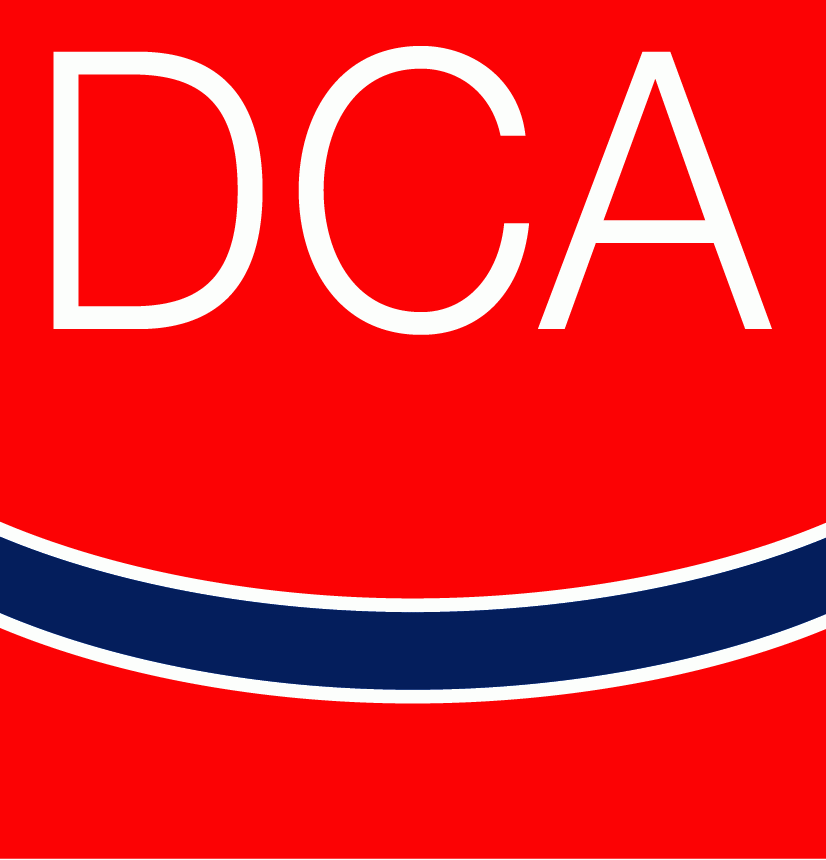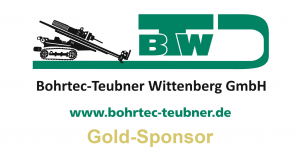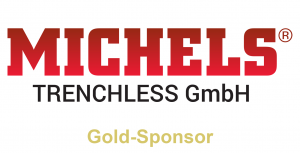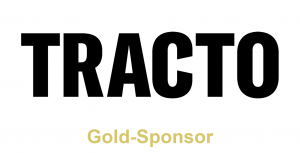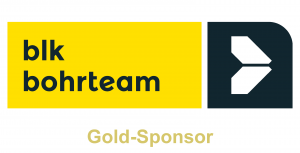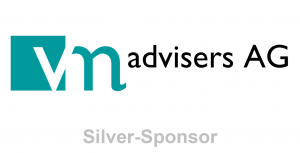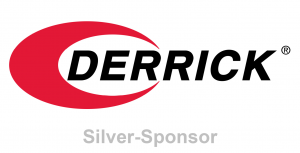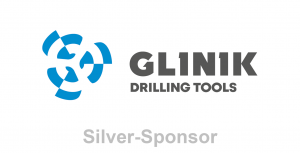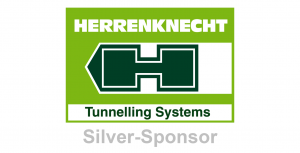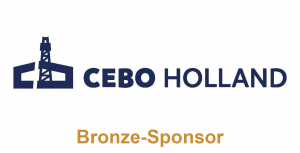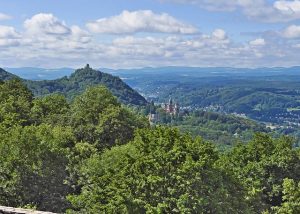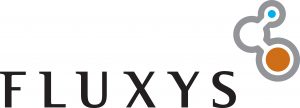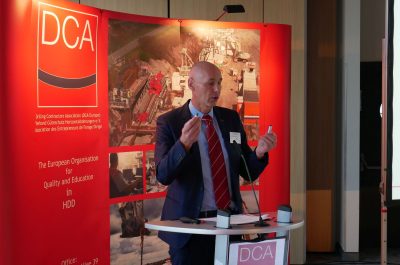
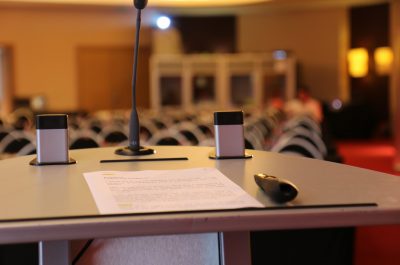

Recommendation – Education – Networking
Annual Congress
The DCA holds its annual congress in October each year, to which European and non-European members of the association are invited, but also other interested parties. The event takes place over three days with an arrival day and two days of lectures.
The event always takes place in alternating years in Germany and other European countries.
In addition to the very interesting conference program with top-class technical presentations, workshops and panel discussions, the DCA offers its members the opportunity to present their company and introduce their own products at an accompanying exhibition. This offer has been taken up very intensively in the past, especially by the associate members.
An entertaining programme accompanies the event with interesting evening events (e.g. visits of a college in Cambridge, UK, or a salt mine in Krakow, Poland),which primarily focuses on the professional exchange between industry professionals and is highly appreciated by the participating members.
Sponsoring
In 2022, the new Annual Meeting Sponsorship Program was introduced (see flyer). The goal is to continue to keep the contributions to the annual congresses stable in the future and thus leave the opportunity to participate open to as many members as possible.
We would like to take this opportunity to thank all the companies that have supported the DCA in the past!
DCA Congresses
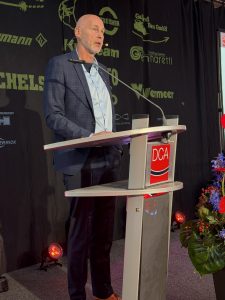


The 29th DCA Annual Congress took place from 8 to 10 October 2025 at the Welcome Kongresshotel in Bamberg.
GOLD-Sponsors of the annual congress:










![]()
SILVER-Sponsors of the annual congress:





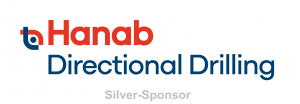
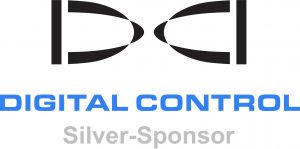
4-time BRONZE sponsor of the annual congress:
![]()
29th DCA Annual Congress with record attendance
The 29th DCA Annual Congress in Bamberg, Upper Franconia, on the topic of ‘Even drillers need rules’, which once again attracted a record number of 250 participants, was opened last week with a high-profile presentation on an overarching topic. The Drilling Contractors Association (DCA) was able to secure Leo Martin, a former German secret agent, who opened the congress with the exciting topic ‘Secret weapons of communication: soft strategies with hard impact’. The many tips on how to communicate in stressful situations were particularly well received by the participants.
This was followed by presentations on topics such as experiences with the use of electrified drilling equipment (by Boris Boehm, Max Streicher) and traffic safety by Maximilian Oppermann from the Oppermann Büro für Verkehrssicherung.
After the lunch break, as described above, an HDD workshop on the topic of ‘Technical Guidelines’ took place, which was very well received. In a total of seven rooms, 20 tables, each with 11 participants and a moderator, discussed the changes in the guidelines. This format can also be used for future exchanges of experience. The association would like to thank the 20 moderators who answered the participants’ questions on the four topics.
On Thursday evening, the Drilling Contractors Association (DCA) had something special on the agenda again. Unlike in Barcelona, the evening event did not take place in a five-star hotel, but in a traditional Franconian barn with barbecue gills, local beer and good entertainment. Typical DCA, always a new approach.
On Friday, as already mentioned, some very interesting HDD projects were presented, focusing on small-scale drilling technology. The event concluded with an HDD presentation from South America by DrillCon, which stood out both in terms of content and presentation style.
All in all, the 29th DCA Annual Congress in Bamberg once again offered a colourful programme of exciting presentations, an exhibition and a workshop that provided many starting points for further discussion rounds (including for the next members’ forum).
A meeting of the Women Empowering HDD (WE-HDD) group has become an integral part of the annual congress. The primary goal of the group’s activities is to promote women in the HDD industry in a sustainable manner. Following the first meeting in Barcelona, another meeting was held in Bamberg. More than 20 women from the HDD industry met at the Bolero restaurant to exchange experiences. One topic at the meeting was the DCA Spring Talks, which were organised by the group itself and held for the first time in May this year. More than 40 participants from member companies were welcomed. A very successful start!
A follow-up is planned for the end of May 2026.
It should also be noted that the Upper Franconian city of Bamberg is really worth a visit. Not only the medieval city centre, which is well worth seeing, but also the lively hospitality really stand out here in a positive way.
Finally, we would like to thank all of our sponsors once again for making this event possible.
See you again on 30 September to 2 October 2026 in the eternal city of Rome, Italy. Please save the date. Note: Only DCA members can participate.
Rückblick Social Program Jahrestagung Bamberg Deutsch
Review Social Program Annual Congress Bamberg English
LECTURES
- Diertmar Quante, DCA Executive Secretary and
- Jorn Stoelinga, DCA-President
- Guest speaker Leo Martin, former secret-service agent
-
Boris Böhm, Max Streicher GmbH & Co.KG
Traffic safety during work beside roads according to RSA 21 and ASR A5.2
- Maximilian Oppermann, Oppermann Büro für Verkehrssicherung
Landingpage “Drill for Europe” – update and possibilities
- Thijs Jansen, Thijs van den Berg
Small and short seeks big and long
- Jan Holtvlüwer, EHB Horizontalbohrtechnik GmbH
Celtic Interconnector: The first HDVC interconnection between Ireland and continental Europe
- François Gandard (OPTIMUM),
- Nicolas BLANC (RTE)
Inner-city large-scale drilling technology for PE pipes under special static loads
- Tobias Männel, Dr.-Ing. Veenker
Ingenieurgesellschaft mbH - Thomas Winkler, LMR Drilling GmbH
- Jacek Janicki, ZRB Janicki
Challenge – Use of small scale drilling in the construction of HGÜ networks
- Bernd Alvermann, Kuhlmann Leitungsbau GmbH & Co. KG
- Jens Schnakenbeck, Kuhlmann Leitungsbau mbH & Co. KG
- Carlos Eduardo Chaves, Drillcon
Sponsors of the Annual Congress
The event was supported by the DCA members Ditch Witch, Michels Trenchless GmbH, Catalana de Perforacions S.A., Vermeer and Schmallenberger as Gold sponsors.

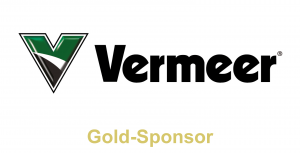
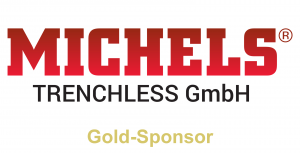
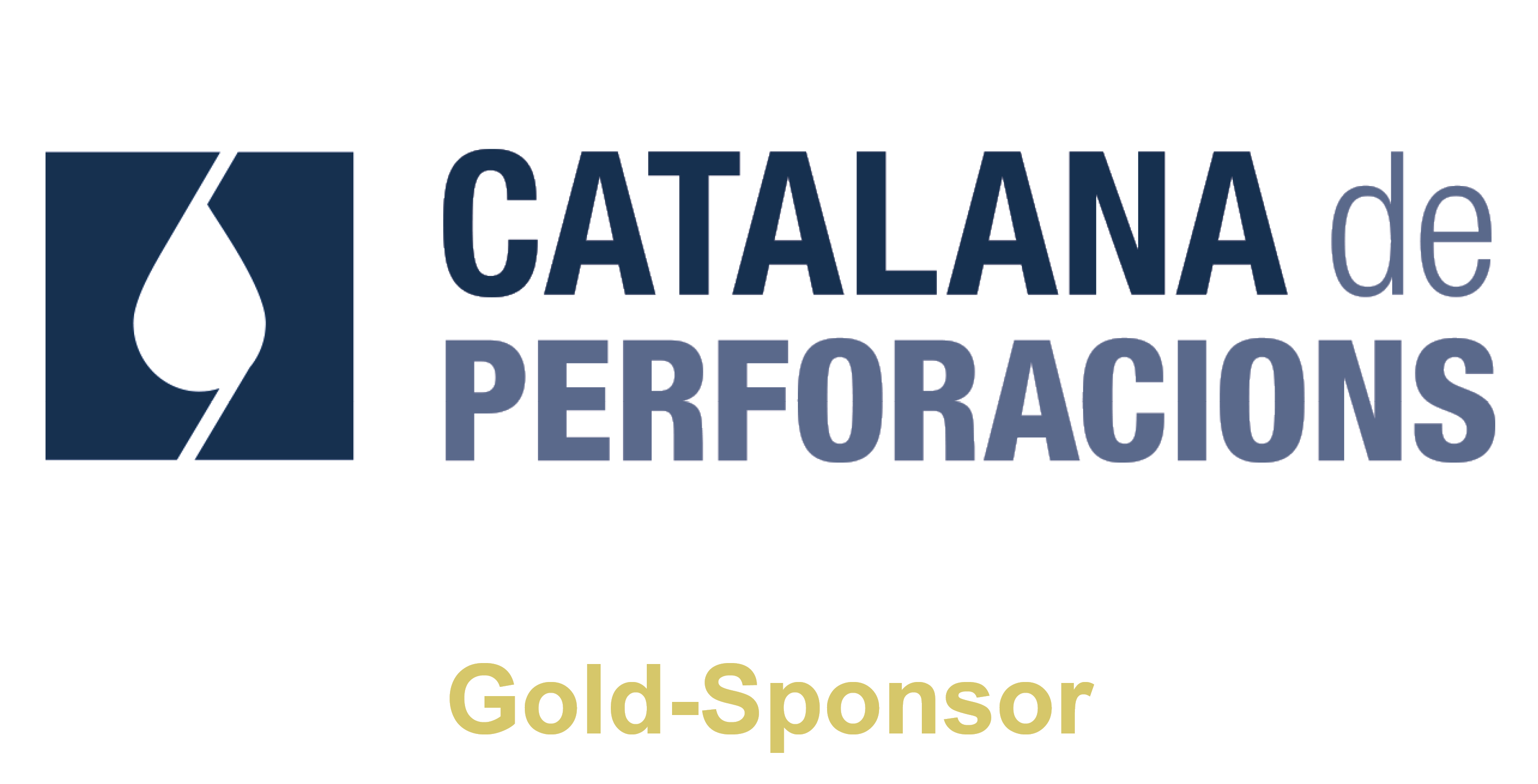
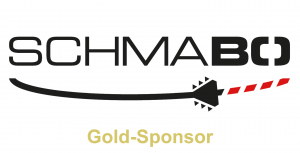

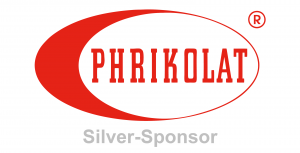



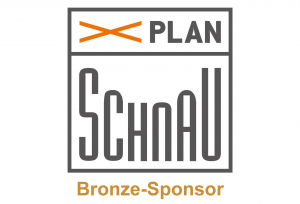

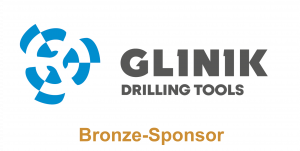
Inspiring young people for HDD technology – HDD Image Film
The 28th DCA Annual Congress, which took place last week in Barcelona, was virtually fully booked, just like last year in Leipzig. With over 230 participants from a total of 12 countries, the DCA continues to consolidate its central position in the HDD industry in Europe. It should also be mentioned that the positive development is not only due to the activities of the board and representatives, but that other interest groups have also formed around the DCA, which want to support the aims of the DCA. First and foremost, this includes the ‘Women Empowering HDD’ group, which was founded at the end of last year.
After a highly interesting introductory lecture by Kim Jansen, generation expert and social psychologist from the Netherlands, who opened the congress with a lecture on the topic of “Generations @ work”, the DCA offered, as always, very interesting lectures and a varied spouse program on both days, which met with great approval from the participants.
The centrepiece of this year’s event was once again a panel discussion, this time on the topic of ‘How to attract and keep people in the industry?’. The panel discussion was moderated by journalist Dr Antje Wöhnke and President Jorn Stoelinga. In addition to the guest speaker, representatives of Generation Z from three DCA member companies took part in the panel discussion. The outcome of the three-hour discussion in the packed congress room was that each generation has its own specific working methods, requirements and goals and that the work ahead can only be mastered by all generations working together on a daily basis, whether men or women.
This was also evident in the new HDD-Image film presented in the run-up to the panel discussion, which was presented to the public at the congress and is intended to promote cooperation in the HDD industry (more on this later).
At the evening event on the terrace of the Hotel Miramar, with a fantastic view of the Mediterranean, the celebrations continued late into the night with music and dancing. The icing on the cake was certainly the DCA logo projected onto the outside wall of the hotel, which was visible from afar.
Friday continued with various HDD project presentations from all over the world, including Germany and Brazil.
The congress documents and presentations as well as further information on the event will soon be available for viewing and downloading in the members’ area.
See you at the 29th edition of the DCA Annual Congress on 8-10 October 2025 in Bamberg, Germany. Please save the date!
Review Social Program annual congress Barcelona English
Review Social Program annual congress Barcelona English
Meeting Women empowering HDD English
Women empowering HDD Meeting in Barcelona English
Lectures
- Dipl.-Geol. Dietmar Quante, Executive Director DCA
- Jorn Stoelinga B.Sc., President DCA
- Drs. Kim Jansen, Generation expert and Psychologist
Overview Red Eléctrica Special Projects
- Sara Fernandez De Sevilla Alfonsea, Red Eléctrica de España
SuedLink: Purpose, Cable & Laying, Future Outlook
- Dr. Stefan Mirschel, TenneT
- Dierk Schönwald, TenneT
Automation and digitalization in small drilling technology – Presentation by ORFEUS
- Lea Freise, TRACTO-TECHNIK GmbH Co. KG
Overcoming geological challenges: A case study of complex HDD’s in the Basque Country, Bermeo
- Jordi Camps Querol, Catalana de Perforacions
Women empowering HDD – Recent activities and outlook
- Lydie Vuille, FOREXI
- Camila Sanchez Prado, HDI
Small-scale HDD on the SuedLink project
- Marco Reinhard, LEONHARD WEISS GmbH Co. KG
- Dr. Christoph Donié, Dr. Donié Geo-Consult GmbH
- Ricarda Puls, Amprion GmbH
- Dr. Maximilian Zundel, gbm Gesellschaft für Baugeologie und – meßtechnik mbH
- Carlos Eduardo d’Oliveira Chaves, Drill Tec, Brasilien
- Jan Laenge, Drill Tec, Brasilien
Sponsors of the Annual Congress
Shortage of personnel at companies is the focus
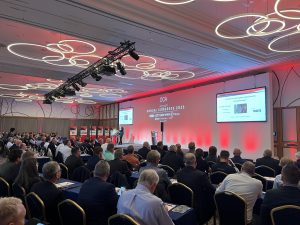 The 27th DCA Annual Congress, which took place last week in Leipzig, was virtually fully booked for the first time with over 210 participants from Europe and the USA. In addition to an attractive congress program, the steady growth in participants is also due to the steady increase in members in Germany and especially throughout Europe. While just over 100 member companies were active in the DCA in 2018, the association will count over 170 member companies by the end of the year. An increase of about 70% in 5 years. Tendency rising!
The 27th DCA Annual Congress, which took place last week in Leipzig, was virtually fully booked for the first time with over 210 participants from Europe and the USA. In addition to an attractive congress program, the steady growth in participants is also due to the steady increase in members in Germany and especially throughout Europe. While just over 100 member companies were active in the DCA in 2018, the association will count over 170 member companies by the end of the year. An increase of about 70% in 5 years. Tendency rising!
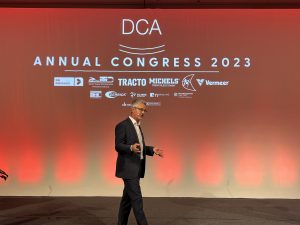 After an introductory highly interesting lecture by Ralf Schuster, geopolitical expert from Frankfurt am Main, who opened the congress with a presentation on “Geopolitics – an explanation for everything?”, the DCA offered, as always, very interesting lectures and a varied supporting program on both days, which met with great approval among the participants.
After an introductory highly interesting lecture by Ralf Schuster, geopolitical expert from Frankfurt am Main, who opened the congress with a presentation on “Geopolitics – an explanation for everything?”, the DCA offered, as always, very interesting lectures and a varied supporting program on both days, which met with great approval among the participants.
The central point of this year’s event was a panel discussion on the upcoming large cable routes (including Südlink, Südostlink) on Thursday afternoon. The panel discussion was moderated by journalist Dr. Antje Wöhnke and President Jorn Stoelinga. During the lively discussion round, which was divided into three sections, topics such as “quality of the tender, technical implementation, duration of approval procedures or the ever-increasing shortage of personnel” were discussed first and foremost. As a result of the approximately three-hour round in the fully occupied congress room of the Hotel The Westin in Leipzig, it could be stated that only through a comprehensive dialogue between project sponsor, planner and client and all other parties involved in the project, the present major tasks can be mastered both in terms of time and technology. The DCA is available as a supporter at any time, so president Jorn Stoelinga.

The topic of “shortage of skilled workers”, which is not only circulating in the HDD sector, was seen by many participants as by far the biggest obstacle to implementation. Delivery times for equipment or materials could be taken into account in planning. The use of machines without personnel is not yet possible despite AI. Among other things, participants called for the establishment of a separate training branch for the next generation of HDD personnel and thus to make the HDD profession as a whole more attractive. This is a task that must also be tackled from the association’s point of view.
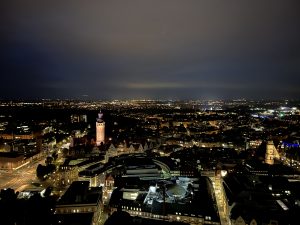 At the evening event in the Panorama Tower in the heart of the city, discussions continued for a long time with a great view over Leipzig and initial solutions were found for the problems discussed. On Friday, the conference continued with various HDD project presentations from all over the world, including Peru and the UK.
At the evening event in the Panorama Tower in the heart of the city, discussions continued for a long time with a great view over Leipzig and initial solutions were found for the problems discussed. On Friday, the conference continued with various HDD project presentations from all over the world, including Peru and the UK.
The congress documents and presentations as well as further information on the event will soon be available for viewing and downloading in the members’ area.
See you again at the 28th edition of the DCA Annual Congress on 09 -11th Oct 2024 in Barcelona, Spain. Please save the date! Please save the date!
Lectures
- Dietmar Quante, DCA Executive Director
- Jorn Stoelinga, DCA President
“Geopolitics – an explanation for everything?”
- Ralf Schuster, Geopolitical Expert
- Franz-Josef Kißing, Senior-Projektleiter Projektmanagement TPPL, Open Grid Europe GmbH
„Hydrogen – infrastructure, market development and expansion”
- Johannes Wege, HYPOS – Hydrogen Power Storage & Solutions East Germany e.V.
Performing at the Danube: in-depth studies and investigations for a safe HDD project
- Dragos Atanasiu, Atanasiu & Skills Alcyme Rambaud, HDI
“How and why to recycle drilling mud in horizontal directional drilling operations”
- Renzo Chirulli, Applications specialist pipeline, Vermeer EMEA Paolo Posocco, Projektleiter, ANESE Srl, IT
- Wladimir Galjard, Geschäftsführer, Galjard Bau GmbH
Moray-West Landfalls – Pipe- Pushing in Scotland – Challenges and Solutions
- Jez Seamans, LMR Drilling UK
Complex sewer renewal with HDD
- Markus Dohmann, Tiefbauamt Backnang
- Marco Reinhard, Leonhard Weiss GmbH & Co KG
Chira River Crossing, Peru: Record-setting HDD project
- Carsten Brueckner, BM Drillin
- Maxime Aera, OPTIMUM
“The importance of HDD in the energy transition – Recent Experiences in the United Kingdom”
- Ross Henderson, HDD Design Manager, OCU Group


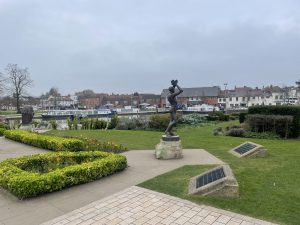
Sponsors Annual Congress
HDD industry an important building block of the energy transition
 The 26th DCA Annual Congress in Stratford-upon-Avon, UK was held as an attendance event and was very well attended with over 145 participants from Europe and the USA. After an absence of 10 years – in 2012 Cambridge was the venue – a DCA Annual Congress was again held on the British Isle. More than 10 new members from the UK in the last two years had persuaded the board to move the association’s main event to the birthplace of the famous playwright and lyricist William Shakespeare in England’s Midlands, despite Brexit. All participants quickly agreed that the professional exchange in the industry “face to face” during the congress and in the course of the once again extremely attractive spouse programme cannot be replaced by telephone calls or video conferences. You simply have to be there!
The 26th DCA Annual Congress in Stratford-upon-Avon, UK was held as an attendance event and was very well attended with over 145 participants from Europe and the USA. After an absence of 10 years – in 2012 Cambridge was the venue – a DCA Annual Congress was again held on the British Isle. More than 10 new members from the UK in the last two years had persuaded the board to move the association’s main event to the birthplace of the famous playwright and lyricist William Shakespeare in England’s Midlands, despite Brexit. All participants quickly agreed that the professional exchange in the industry “face to face” during the congress and in the course of the once again extremely attractive spouse programme cannot be replaced by telephone calls or video conferences. You simply have to be there!
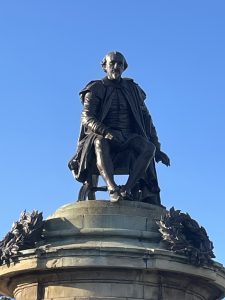 “To drill or not to drill, that’s the question ” was the stylish motto of the conference, or perhaps in other words, “how and by whom should the multitude of HDD projects in the course of the energy transition, the connections of the wind farms, the north-south connections of the high-voltage cables, the upcoming pipeline relocations and not to mention the acute broadband expansion in the next two decades actually be carried out”. The investments that are being made are reaching dimensions that pose a great challenge to the industry in the wake of a constant shortage of skilled workers and supply bottlenecks, but thus also characterise it as an important building block of the energy transition, without these projects cannot in fact be realised. In addition, there are technical challenges for HDD technology and the supplier industry, especially in the area of laying the power lines, which have yet to be solved. These and other questions were discussed and answers sought during the three-day congress.
“To drill or not to drill, that’s the question ” was the stylish motto of the conference, or perhaps in other words, “how and by whom should the multitude of HDD projects in the course of the energy transition, the connections of the wind farms, the north-south connections of the high-voltage cables, the upcoming pipeline relocations and not to mention the acute broadband expansion in the next two decades actually be carried out”. The investments that are being made are reaching dimensions that pose a great challenge to the industry in the wake of a constant shortage of skilled workers and supply bottlenecks, but thus also characterise it as an important building block of the energy transition, without these projects cannot in fact be realised. In addition, there are technical challenges for HDD technology and the supplier industry, especially in the area of laying the power lines, which have yet to be solved. These and other questions were discussed and answers sought during the three-day congress.
After an introductory, highly interesting presentation by Heinz Leuters, experienced pilot and flight instructor as well as certified management expert on the topic “Don’t f**k up the Landing” “Mastering risks when they occur – Making situation-specific decisions”, two workshops on the topics “The role of drilling fluid in the borehole“ and “Accuracies in HDD drilling” were held in addition to interesting presentations on HDD technology. Conclusion: Both topics have by no means been worked through and discussed to the end. Translated with DeepL.com (free version) However, there is a clear tendency to discuss the topic of “Accuracy in HDD drillings” in more detail at the next DCA members’ forum in May 2023.
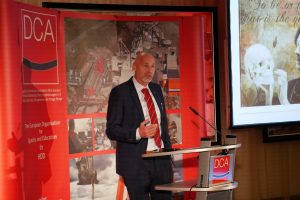

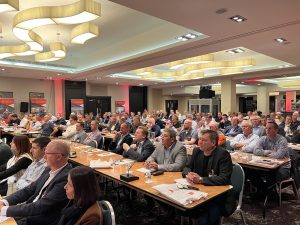
From the series of technically and thematically very appealing presentations on both congress days, the joint presentation by Renzo Chirulli, Vermeer and Thorsten Kaas, Max Streicher GmbH & Co. KG on the subject of “Plug & Drill – The fully electric HDD Jobsite”. Although both companies are factually competing on the market and thus naturally want to place their products and services first and foremost, the two lecturers understood how to present the topic in an excellent manner, factually and technically at a high level, without the focus on their own product becoming apparent here. From the point of view of President Jorn Stoelinga and his board, the lecture was a living association work in the sense of the DCA family! Many thanks for that!
See you again at the 27th edition of the DCA Annual Congress on 4-6 October 2023 in Leipzig in the east of the Republic. Please note the date!
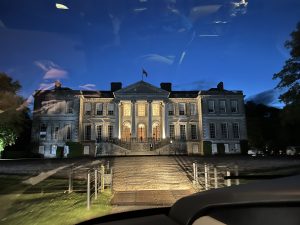


Downloads
Lectures
DON’T F**K UP THE LANDING Mastering risks when they occur – Making situationspecific decisions
- Heinz Leuters, You Have Control, Leuters Consulting
Offshore wind outlook and supply chain – opportunities & risks based on the UK/EU market
- Catherine Goineau Spangsberg, Orsted
Swarm Robotics in underground construction
- Patrick Lane-Nott – Director of Engineering, hyperTunnel Ltd.
- René Schrinner, Tracto-Technik GmbH & Co.KG
Plug & Drill – The fully electric HDD Jobsite
- Renzo Chirulli, Vermeer
- Thorsten Kaas, Max Streicher GmbH & Co. KG
HDD in the context of the energy transition – The price of higher expansion targets
- Ronald Siebel, TenneT Offshore GmbH
Tulloch Watermains Upgrade UTX, Oban, Western Highlands, Scotland
- Chris Brodie, BDM GMac Utilities Ltd
- Lydie VUILLE, Forexi
Workshop 1A: Rolle der Bohrspülung im Bohrloch
- Stefan Gottschalk, SIRIUS ES Deutschland GmbH
- Ferenc Kriwitzki, Cebo/Baroid IDP
Workshop 1B: The role of drilling mud in the borehole
- Marco Reinard, DCA-Vicepresident
- Henning Söker, AMC Europe GmbH
- Krzysztof Dębicki, Heads Sp. Zo.o.,
- François Gandard, OPTIMUM
Workshop 2A und B: Accuracy in HDD-Drillings
- Ronald Siebel, DCA-Board Member
- Jörg Himmerich, DCA-Board Member
Certificate of Attendance
Here you can download your certificate of attendance: Certificates Annual Congress 2022
Sponsors of the Annual Congress

![]()
HDD industry faces major challenges in Germany
The 25th DCA Annual Congress in Bonn, Königswinter again took place as a live event and was able to report a new record with over 160 participants. They all felt that meeting “face to face” is by far the best way for a professional exchange in our industry and during the again very attractive social program.

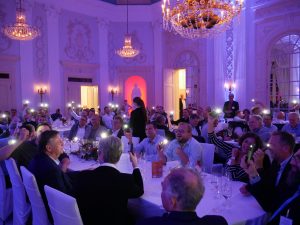
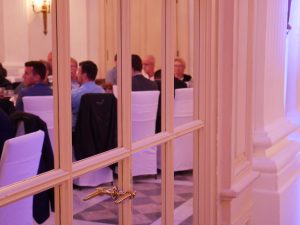
The event, which was held under the motto “From Pipe to Cable”, was dominated by the many and varied tasks facing the HDD industry as a result of the energy transition and the expansion of broadband in Germany. The investments that will be made in both areas over the next few decades are reaching dimensions that the industry has never seen before in this concentrated form. HDD will play an important role in both broadband expansion and the laying of power lines from north to south in Germany. This situation will not be different in other member countries. in other member countries. As things stand at present, the capacities of qualified planning and civil engineering companies available on the market will not easily be able to meet the demand. The challenges that still have to be overcome from a technical point of view, including the laying of power cables in crossing areas using HDD, were given a brief foretaste in the presentation by Tennet.
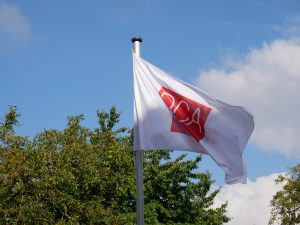


After a highly interesting introductory lecture by Prof. Dr. Martin Korte from the Technical University of Braunschweig on the topic “Shaping the future – paradoxes of decision-making”, two workshops on the topics “Subsoil parameters” and “Drilling fluids and cuttings, disposal and recycling” were held in addition to the lectures on the aforementioned topics. Intense discussions took place in the workshops. Conclusion: Both topics are far from being finalised.
Downloads:
DCA_Jahrestagung_Programm_2021
DCA_Annual_Congress_Program_2021
DCA Annual Congress 2021_Digital Handout
Lectures and Workshops
- Dipl.-Geol. Dietmar Quante, Executive Secretary DCA
- Jorn Stoelinga, B.Sc., DCA-President
Shaping the Future – Paradoxes of Decision Making
- Prof. Dr. Martin Korte, TU Braunschweig
Status and Prospects for Fibre Optic Expansion in Germany
- Daniel Seufert, Referent Bundespolitik & Kommunikation BREKO Bundesverband Breitbandkommunikation
HDDs and special solutions – Project Südlink
- Dipl.-Ing. Wolfgang Kuhn, TransnetBW GmbH
Lissos River, a challenging HDD Crossing in Greece
- Alexis Filliette, Operations Director HDI
- Jez Seamans, LM Drilling UK
Little Barford – The Drilling labelled as a project that ‘could not be built’
- Scott Williams, Operational Manager, Peter McCormack & Sons Limited
Limits of HDD vs. the wishlist of electrotechnology
- Ronald Siebel, Technical Specialist HDD, Tennet Offshore GmbH
Developments within Pipe and Cable installation technologies
- Dr. Marc Peters, Herrenknecht AG
- Dipl.-Ing. (FH) Michael Lubberger, Herrenknecht AG
Workshop 1A: Baugrundparameter
- Marco Reinhard, DCA-Vicepräsident
- Christoph Donié, Dr. Donié Geo-Consult GmbH
- Dan Lingenauber, Tracto-Technik
Workshop 1B: Subsoil Parameters
- Marc Schnau, DCA-Vicepresident
- Francois Gandard, OPTIMUM
- Henk Kruse, Deltares
Workshop 2A and 2B: Mud and Cuttings – Disposal and Recycling
- Jörg Himmerich, DCA-Board Member
- Jorn Stoelinga B.Sc., DCA-President
Sponsors of the Annual Congress
Press report trade journal bi-Umweltbau
Im Zeichen des Umweltschutzes
DCA executive secretary Dietmar Quante welcomed about 145 participants at the 24th annual congress on 16-/18 October 2019 in Krakow. The environmental factor in particular was the focus of attention, including drilling in nature reserves and electrically operated drilling rigs.



In Poland, a lot has happened in the field of HDD, especially in recent years. This was demonstrated by Roland Kośka of Gaz-System S.A. in his lecture. Over the past ten years, the gas network operator has continuously expanded its network, using HDD in particular in addition to the Microtunneling and Direct Pipe processes (in more recent projects). In the past, however, inadequate equipment, faulty planning and lack of construction supervision made the work more difficult. More uniform standards and significantly more competition on the Polish HDD market have considerably improved the situation in recent years, according to Kośka .
Technical solutions instead of lifestyle changes
“HDD is considered a green environmentally friendly technology, but there is always room for improvement in our industry,” said DCA President Jorn Stoelinga. In his opinion, HDD can be made smarter and more environmentally friendly. Prof. Dr. Dr. Dr. h.c. explained what is necessary for this. Franz-Josef Radermacher put it in a nutshell: Technical solutions are the key, said the Professor of Computer Science at the University of Ulm and a member of the Club of Rome. Against the background of population growth and climate change, less consumption and lifestyle changes, as called for in many philosophical debates, are hardly effective. “Instead of expressions of fear, we should rather ask ourselves which solutions make it possible to achieve a certain standard of living for more people in the world,” said Prof. Radermacher with a small side blow to climate activist Greta Thunberg. “Technologies can change the world, but we need resources for that.” Green energy in particular, for example in the form of synthetic fuels, is an important building block here.
E-Rigs a real alternative?
Environmental protection was also one of the aspects discussed in the parallel workshops. The first one dealt with electrically operated drilling rigs. While last year the small HDD devices were in the foreground when it came to digitization, electrical systems are obviously more interesting for large drilling technology, even though there is a lack of long-term experience with fully or partially electric devices. The workshop participants identified reduced emissions in particular as the main advantages of electrically operated drilling rigs. Thus, the use in sensitive areas is also possible under compliance with special environmental regulations. With regard to noise emissions, the use of E-rigs is particularly advantageous for residents, but also for equipment operators. An oil change and any environmentally harmful leaks are no longer necessary for electrical systems. In addition, maintenance costs for electrical systems are lower and control over speed and control is more precise, as one participant reported. It is also interesting to electrify the high-pressure pumps because of the great savings potential. On the other hand, the greater (transport) weight and the high acquisition costs for electrical drilling equipment prove to be disadvantageous. All in all, the technology still has to mature in many areas, e.g. when it comes to the correct cooling of electric motors or mobility (moving the equipment) on the construction site, and greater competition is naturally conducive to further development.



The second workshop presented and discussed the trenchless pipe-laying methods currently available on the market for the HDD process (Microtunneling, Easy2Jet, System 2, E-Power Pipe, Pilot Pipe Jacking, Pilot Pipe Jacking, Direct Drill, Easy2Jet, HDD Arc Drilling, Direct Pipe). The level of knowledge of the participants was very different. Nevertheless, advantages and disadvantages compared to the HDD procedure could be worked out, whereby quite objectively and without the “HDD glasses” was judged. Some methods, such as Microtunneling or Direct Pipe, are suitable as independent methods for a wide range of applications, while others represent a modification of methods for special applications. The participants suggested to create an understandable overview of the available processes and their specifics. The DCA examines whether this can be developed, for example, at a subsequent HDD forum or by a DCA task group.
Drilling in (nature) reserves
Before Dipl.-Ing. Silke Goldschmidt, WBW GmbH, spoke about challenges in small drilling technology and, among other things, identified inaccurate descriptions in tenders as well as missing information on the part of clients or planners, e.g. on the subsoil or on possible construction roads as problems, Dipl.-Geol. Dr. Hans-Joachim Bayer and Dipl.-Ing. Dan Lingenauber from Tracto-Technik dedicated themselves to the “construction of glass fibre cables in HDD processes in biotopes and biosphere reserves”. Dr. Bayer presented four glass fiber and one wastewater project in Germany and Switzerland, in which pipes were laid in strictly protected areas. In addition to the drilling requirements in sometimes very difficult terrain, he explained in particular the very specific nature conservation requirements that had to be observed in the HDD measures. Lingenauber continued the lecture with an overview of the large number of different protected areas. He pointed outthat HDD projects often offer unique possibilities for pipeline construction in protected areas and make this possible in valuable ecosystems in the first place. On the other hand, there are also high biological construction requirements for the drilling work, said Lingenauber.
James Worth, project manager at Volker Trenchless Solutions (VTS), then reported on the mega-project “East Anglia One”. This is a huge offshore wind farm in the North Sea, which is currently being built off the coast of England. 148 HDD wells were drilled under various conditions. For example, the routes were partly in nature reserves, where there were strict requirements on noise emissions and animal welfare. Many helpers were involved in archaeological reconnaissance work (note: I don’t think so…) in order to secure any finds; in some cases even new routes had to be found.
The lecture programme of another successful informative annual congress in Krakow ended with a lecture on crossing the Oder by means of a 40″ pipeline over a length of 1,180 metres.



In addition to the lecture programme, the DCA also offered an interesting spouse programme for all participants. In addition to a visit to the city of Krakow, which is well worth seeing, and a guided tour on the subject of “Jewish Life in Krakow”, including a visit to Oskar Schindler’s factory, the evening event took place at the Wieliczka 135 m salt mine in the Warsaw Festival Hall on Thursday.
DCA_Jahrestagung_Programm_2019
Sponsors of the Annual Congress
Press report trade journal bi-Umweltbau
Focus on digitisation How great are the effects of digitization on the present and the future of controlled horizontal drilling technology?This was one of the main topics of the 23rd Annual Congress of the Drilling Contractors Association (DCA-Europe), which took place this year in Oberursel near Frankfurt.
DCA Executive Secretary Dietmar Quante was pleased with the great response in Oberursel. Nearly 150 participants were a record attendance for an annual congress of the association. One reason for this may have been the attractiveness of the venue and the lecture programme as well as the current activities of the DCA in its task groups, to which DCA President Marc Schnau referred in his welcoming speech.



Active task groups
Over the past few months, a task group has intensively researched the legal aspects as well as the various technical possibilities of processing and disposing of drilling fluids. “In practice, however, these possibilities repeatedly reach their limits,” Schnau stated soberingly. “Unfortunately, the original goal of softening such limits, simplifying processes or developing special solutions together with the Ministry of the Environment could not be achieved.” Schnau announced that an information leaflet on this topic from the DCA will soon be made available to its members.
A second working group dealing with the topic of coating qualities is also on the verge of publishing its results. A new task group has been set up to review and revise the DCA guideline.
Digitisation is moving the HDD industry in two respects. On the one hand, the expansion of the network infrastructure is ensuring full order books for many drilling companies. “On the other hand, digital technology offers new possibilities for control, automation, data acquisition and data transfer on the equipment and machines used in horizontal drilling technology and in project preparation”, Schnau explained, describing the background for the motto of the DCA annual congress: “HDD towards 4.0”.
Digitization changes the world
In his opening speech on the Internet of Things, Adri Wischmann, innovation expert and owner of the Internet company IoT Netherlands, made clear the influence that the Internet and digital networking already has and will have today and even more so in the future on the most diverse areas of life. Digital networking in combination with artificial intelligence will dramatically change life in our homes, at work and in our cities, predicted Wischmann and made this clear with illustrative examples. “You can have an alarm clock next to your bed that is connected to your online daily planner. At a morning appointment, the alarm clock can check the weather and traffic conditions, calculate the travel time and wake you up a little earlier if necessary. The clock could even check the tank capacity of your car to decide whether you need to stop at the petrol station and take this into account,” Wischmann explained as an example of a possible scenario for a smart future. He also described the possibilities of new business models and gave a brief insight into the principle of blockchain and crypto currencies on the Internet.
Network expansion making progress
Before Adri Wischmann’s visions can fully become reality, however, the necessary infrastructure is required. Alexander Bruns reported on the technical status of the laying methods and the future prospects for the fibre-optic expansion at EWE Netz. EWE is pushing ahead with the network expansion with high investments, Bruns explained. 1.2 billion is earmarked for broadband expansion over the next 10 years. EWE has analysed the different laying methods in the wide area and distribution networks for their respective strengths and weaknesses and uses them in accordance with the respective boundary conditions. The HDD method is primarily used in the wide area network outside the towns and villages and is the ideal solution, especially for crossings and intersections.
With easy2jet, Bruns presented a still young flushing lance process for the production of house connection pipes, which is currently being tested at EWE. Water is pumped through a PE rod to the bevelled flushing lance head. This loosens the existing soil and the PE pipe can be pushed forward with muscle power. The rotation of the drill string is generated by a battery-operated hand drill. Based on previous experience, the method is ideally suited for sandy and loamy soils and enables low laying depths with FTTH expansion and higher daily outputs compared to open construction methods.



Discussions in workshops
One focus in Oberursel was on two workshops held in parallel. One was based on the overarching theme of the annual conference and dealt with the digitalization and automation of processes on the HDD construction site. As far as machine technology is concerned, small drilling rigs are obviously a big step ahead of large rigs when it comes to recording, storing and providing data or automating processes such as changing rods. It was discussed whether the DCA should develop a practice-oriented standard for the data generated on the construction site and thus channel the flood of data sensibly.
It has been reported from Italy that surveying engineers are already supervising pilot drilling surveys from their offices far away from the construction site and at the same time taking care of more than one construction site. A similar development seems to be emerging in the measurement and evaluation of drilling fluid.
All in all, digitisation is also progressing on HDD construction sites and offers considerable opportunities for the future. However, the qualification of the personnel remains indispensable, a conclusion of this discussion.
With a view to updating the technical DCA guidelines, the second workshop dealt with the question of whether the same requirements should apply to less complex small-scale drilling measures as in large-scale drilling technology or whether a differentiation should be made in the guidelines in line with the complexity of the respective measure. In the discussion it became clear that the size of the drilling equipment used was not suitable as a grid for such a possible differentiation. Whether a drilling is demanding or simple depends on other criteria. The speaker of the workshop, Tim Jaguttis, stressed that these considerations were not about softening the rules of the DCA. Rather, it is a matter of creating more validity and acceptance for the rules and thus the quality standards of the DCA in practice through possible adjustments. The workshop emphasized the role of the large contracting authorities and their tendering practice for compliance with quality standards in small drilling operations. Clear criticism was expressed that no representatives of these companies took part in the annual congress and that they had missed the opportunity for exchange and dialogue with the industry. This topic was also discussed at the Members’ Forum in the “Small Scale Drilling” workshop in early 2019.
A look into practice
The second day of the congress was traditionally dedicated to practice. Two new members of the DCA, Josef Raedlinger Ingenieurbau and Anese from Italy took the opportunity to introduce themselves in more detail with the presentation of demanding drilling projects, before Dr. Hans Joachim Bayer in his concluding lecture raised the question of whether HDD technology could not also open up new fields of application and thus new markets in the field of geotechnical applications such as rock stabilization, drainage or tunnel construction in addition to the laying of pipelines.
Bayer’s presentation concluded an informative and discussion-packed annual congress in Oberursel.
DCA_Jahrestagung_Programm_2018
DCA_Annual Congress_Program_2018
DCA_Annual Congress_Brochure_2018
Sponsors of the Annual Congress
Press report trade journal bi-Umweltbau
To frankly exchange experiences when dealing with problems around the HDD method was in the focus of the annual congress Drilling Contractors Association DCA in Dutch Dordrecht.
More than 120 participants could be welcomed by DCA’s executive secretary Dietmar Quante in this second eldest city of the Netherlands near Rotterdam to the 22nd annual congress of the association. Thus the response to this event that is held at alternating locations in Europe was at the same high level like in the past years.



Active task groups
Marc Schnau who presented the congress for the first time as DCA’s new president, emphasized in his opening address the activities of two task groups. On the one hand the issue disposal of drilling fluids and drill cuttings still receives the industry’s main interest. The DCA aims to work out minimum standards and a reliable guideline that can be applied to all HDD measures. Furthermore it shall meet the contractors’ demands in terms of legal certainty, practicability and economic efficiency. This is a complex enterprise that requires numerous discussions with those responsible, not only from the HDD field, but also from ministries and clients. Against this background Schnau asked for some patience and announced that at the next members’ meeting in February new intermediary findings will be on hand. The work on the issue coating quality makes good progress according to Marc Schnau. “We will soon be able to expect results”, said DCA’s president.
Review and perspective
H.J. Brink of the Dutch Gasunie opened the lecture programme with a survey of the developments in the directional horizontal drilling technique from the client’s view. Experience dates back to 1984. Then the first drilling was performed in the Netherlands. By order of Gasunie a drilling of 600 m to lay a gas pipeline DN 450 under a waterbody in Amsterdam was successfully executed. The next two drillings followed the same year. Since that time this construction method was increasingly established in pipeline construction in the Netherlands – even if some problems had to be encountered at times. The HDD method has been technically enhanced, and clients, too, created standards that are conducive to minimize risks around HDD projects.
Then followed Willem Smelik of Meewind Netherlands who informed about the current situation and perspective of the offshore wind energy. Alexander Cambier of HDI from France reported about two demanding drillings of 1,500 m underneath runways of the airport Charles de Gaulle in Paris. This project to lay power supply lines in the course of the airport expansion provided not only technical challenges. Working under the special conditions of airport operations made high demands on the logistics of such a site as well.



“Trouble Shooting” in Discussion
Using spectacular pictures of ruptured drill rods, worn tools and failed drillings, DCA’s board member Jorn Stoelinga of Visser & Smit Hanab primed the audience for the main topic of this year’s annual congress with his lecture titled “Oh my god”. As part of a panel discussion, current problems and technical difficulties relating to horizontal directional drilling technology were discussed under the motto “HDD trouble shooting” and experiences were exchanged in an open discourse. “We, the active DCA members, are also all in competition with each other, both with conventional pipe laying and with other trenchless construction methods,” explained Marc Schnau. In terms of accuracy and reliability, these often still have a head start. “We have to try to reduce this lead, namely by learning from our experiences and mistakes – ideally not only from our own ones but from those of the whole field of industry”, said DCA’s president. The panel discussion should be the start of a kind of “failure culture” within the DCA. Objective is to help all members to better solve their problems occurring and thus further improving the reputation of the HDD method.
The discussion was moderated by F.-J. Kissing of Open Grid Europe and touched a number of problematic issues, partly with projects in practice. For example failure and wearing of rods and tools were picked out, or the control of the drilling and blowouts, pipelines that are stuck, pipe coatings and the communication between client and contractor. It was pretty obvious that the panel members and the audience were not yet familiar with this kind of mutual discussion about sensitive issues. Anyhow, those responsible from the DCA observed good approaches from the participants initiating a vivid discussion. DCA’s board will continue this course was later announced.
Practical Experience
The second day was characterised by predominantly technical issues. Dan Billig of Prime Horizontal, for example, reported about the development and current state of Wireline control systems in HDD; Thorn C. Huffmann of Tiger Trading explained what it takes to choose the appropriate drill rod. Under the heading risk management, the lawyer J. Kevin Mullins elaborated what has to be observed when a construction contract is formulated so that soil risks are not imposed on the contractor in an unfair manner.
The conclusion was a double presentation by Dr. Christoph Donie of Dr. Donie Geo-Consult GmbH and Günter Kruse of LMR Drilling who talked about the basic geo-technical conditions and the performance of an utmost demanding crossing of river Danube between Bulgaria and Romania. The two drillings of 2,100 m each through a particularly tricky geology had numerous challenges in store but could finally be successfully accomplished within the given time frame.
With this spectacular project the 22nd annual congress nearly came to an end.
DCA_Jahrestagung_Programm_2017
Sponsors of the Annual Congress
Press report trade journal bi-Umweltbau
Soil and Rock in the Target of HDD
This year’s annual congress of the DCA in Hamburg primarily focussed on geological and geotechnical peculiarities in view of HDD measures. Aktuelle brisante Themen waren nach wie vor die Spülungsentsorgung sowie das neue System der Homogenbereiche.
DCA’s president Hermann Lübbers prepared the almost 140 participants for the congress: “The DCA may never be vegetating as administrative machinery.” It was always important to develop visions and solutions, for example in view of use and disposal of drilling fluids that were currently “boosting the costs of directional horizontal drillings in an exorbitant way”. “Clients drastically reduce their tender offers for directional horizontal drillings these days. Counteraction is essential now, otherwise the technique of directional horizontal drilling will considerably lose market share”, Lübbers warned.



The lectures of the first congress day dealt firstly with network development. M. Eng. Robin Dornauf of the Bundesnetzagentur reported about the federal planning of demand, the priority of underground cable of lines for high-voltage direct-current transmission and about planned projects in the coming years. Then Dr.-Eng. Enno Wieben of EWE Netz GmbH reported about the connection of energy and gas networks (sector connection) as “key to the energy switch” and the prospects of seasonal energy storage in gas networks. Electrifying gas compressors in particular offered quick and cost-efficient potential for sector connections.
The ensuing traditional site visitation led to autobahn A7 in Hamburg. This busy autobahn is not only being extended at the moment but will also receive several noise protections, for example in Hamburg-Schnelsen.
Geology in the Focus
The second day centred on interesting HDD projects, as well as technical and particularly geological aspects.
M. Eng. Stefan Reich of HPC AG presented a project in Hamburg’s emerging district HafenCity where directly on tidal Elbe a building complex is being erected. Given in-situ backfill and organic mud bottom, it was necessary that the buildings had a deep foundation on piles. This required intensive geotechnical supervision by the engineers of HPC during the planning and first construction phase. In particular the water table had to be measured on a regular basis, and the setting properties of the mud bottoms had to be calculated. Despite ingress of water into the construction pit a safe foundation could be achieved as soon as a leak in the bank wall was sealed by means of filter load and concrete seal.
Dipl.-Ing. Günter Kruse of LMR Drilling GmbH was also especially preoccupied with the issue geology when he presented a HDD project in Northern Spain. Over a length of scarcely 700 m a steel pipe DN 800 should be laid. A foundation soil analysis showed that not only sand, gravel, clay and silt had to be expected but above all also karstic limestone that possessed violent decay and lacunae because of water currents. This caused concern that considerable loss of drilling fluids had to be expected during the pilot drilling; therefore the drill hole had to be cemented several times. Pumping of the cement suspension was carried out by a pipe open at one ending. All in all 172 tons of cement were applied in this project. When the cement plug had hardened, they could proceed with the pilot drilling without loss of drilling fluids.



The currently most controversial issue “homogeneous zones” was portrayed by Prof. Dr.-Ing. Kurt-Michael Borchert of GuD Geotechnik und Dynamik Consult GmbH; DCA’s executive secretary Dietmar Quante had explicitly pointed out to his lecture in his opening address. After the amendment of the VOB/C last year, the corresponding ATV standards replaced the former soil classes by homogeneous zones. The multitude of possible classifications of the former schedule had often brought amendments about. “Some clients tendered classes 1 to 7; thus they could not go wrong”, bantered Borchert. The new homogeneous zones provided a standardised system for soil and rock description that considered special requirements of the individual crafts and described the construction soil independent from the device applied. Compared to the former classes, the greater number of parameters offered more options to determine deviations during construction work, said Borchert. Reduced costs, however, were not necessarily proven by these individual parameters. Additional expenses had to be justified by the respective evidence, for example calculated digging resistance that had to be presented with the parameters from the scope of work compared to the new parameters. “Geotechnical experts will still have to deal with changing soil conditions and probably with more differentiated evidence,” predicted Borchert.
Trendsetting Radar Technology
How to effectively detect obstacles and third-party lines in the soil during HDD drillings was the issue of Dr. Hans-Joachim Bayer of Tracto-Technik GmbH & Co KG, using the EU-funded ORFEUS project. After some development work a radar antenna could successfully be mounted to the drill head. It can explore the soil without restricting the controllability of the drill head. Using a special connector system, huge amounts of data like they are essential for the radar technology can be transmitted. Meanwhile this radar system successfully proved its worth at several test sites in Stuttgart, St. Denis near Paris and Ljubljana/Slovenia. Dr. Bayer hopes that the project will further be supported so that the system can be launched in about two to three years. One or the other detail, however, need improvement, said Dr. Bayer, for example the automatic deactivation when lines are approached.
At the end of the event all participants benefitted from gaining new knowledge and insight into various topics from interesting lectures and intensive discussions.
DCA_Jahrestagung_Programm_2016
Sponsors of the Annual Congress
Press report trade journal bi-Umweltbau
The tightened situation concerning the disposal of used drilling fluids in Germany was a topic that was particularly discussed by German participants in the annual congress of the DCA in Marseilles.
DCA’s executive secretary Dietmar Quante could welcome more than 110 participants to the 20th annual congress of the association. This year Marseilles on the French Mediterranean coast had been chosen as appealing setting for the event by those responsible. “Our association makes connections between HDD companies and all others that are involved in the market from all over Europe and even beyond,” said Quante referring to the choice of venue. He emphasized DCA’s international orientation alluding to the editions of the association’s technical guidelines in French and English that could be finalised right before this annual congress.



The president of the DCA, Hermann Lübbers, had reason to address a topical hot issue in Germany. Foil is the decree of the Lower Saxon Department of the Environment from summer 2015 that was drastically restricting and bedevilling the disposal of drilling fluids and cuttings from directional horizontal drillings. Lübbers emphasized that the DCA had not been inactive in view of this matter. Three years ago, he had already addressed this issue at a members’ meeting. The DCA first concentrated on the legal aspects of the problem, illuminating the attitude of clients and contractors in this matter. Conversations had been held with representatives of the Sonderabfall-Management Gesellschaft SAM (hazardous waste management society) in Mainz; this society was directly subordinate to the respective ministry in Rhineland-Palatinate. Additionally talks were held with the Department of the Environment in Hanover. “Whether we want to face up to it or not: we do have a problem with the disposal of drilling fluids and drilling cuttings,” Lübbers explained. The legal basis had been laid some time ago already; it had not been consistently transferred into action, however. Representatives of the Lower Saxon Department of the Environment promised the DCA their willingness to find practicable solutions; they were even willing to cooperate actively in a task group.
Market, Rules, and Technology
Josselin Nivet of the French gas network operator TIGF opened the lecture programme. The company is running a gas distribution system of 5,064 kilometre’s length in Southwestern France. Nivet elaborated the reasons why the HDD technology played an important role in developing and extending this network. It was applied, for example, to lay pipelines reliably underground that were integrated into bridge constructions, and to cross water bodies and traffic routes when networks were extended. In the coming two years, TIGF was planning 12 concrete HDD projects, Nivet explained.
Other lectures of the first day were presented for example by Carmen Rodríguez of the European Network of Transmission System Operators for Gas, ENTSOG, introducing the 10 year network development plan for Europe. Then the international audience was informed by DCA’s president Hermann Lübbers about peculiarities and content of the new ATV (DIN 18324), positioned in the VOB and especially valid for directional horizontal drillings. DCA’s board member Marc Schnau reported about innovations in the revised and updated Technical Guidelines.



Technical issues and interesting sites were in the centre of attention on the second day of the congress. Michael Lubberger of Herrenknecht reported about a new full section drilling tool that should improve performance and efficiency of HDD in solid rock. Soil exploration was Dominique Feldmann’s topic, of Forexi. He presented the French standard NF 94-500 that functions as basis for geo-technical explorations in HDD projects. Jan Spiekout of DNV GLOil & Gas used his lecture to explain the mechanisms that determine the deterioration behaviour of pipelines. He described the criteria that have to be observed when the decision was made to replace a pipeline.
Lectures about spectacular construction sites rounded the programme off. Alexis Filliette, project manager at HDI, referred about a drilling with a length of 1,300 m to lay a gas pipeline with a diameter of 24’’ in Brazil. And Jez Seamans of LMR Drilling presented a project from Scotland: a water pipeline with a diameter of 1,000 mm was laid in an ecologically sensitive environment; in the process a mountain was undercrossed with a rock well on a length of 695 metres.
At the end of the annual congress, Hermann Lübbers could draw an overall positive conclusion: Multifaceted lectures, the ambience of a harbour city that appeared cosmopolitan and with a long standing tradition, temperatures reminding of summer with a bright blue sky, and ample opportunity for discussion and exchange of experiences within the HDD industry on an European level in Mediterranean atmosphere gave distinction to DCA’s annual congress in Marseilles.
DCA_Jahrestagung_Programm_2015
